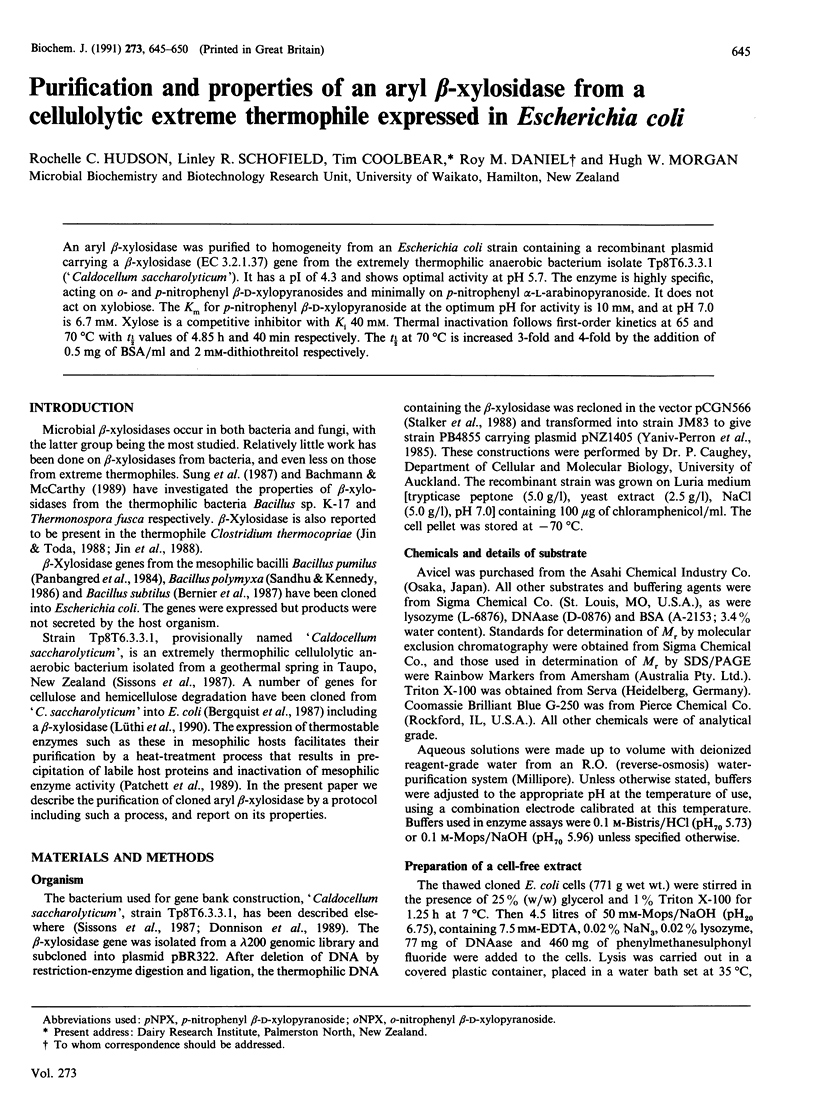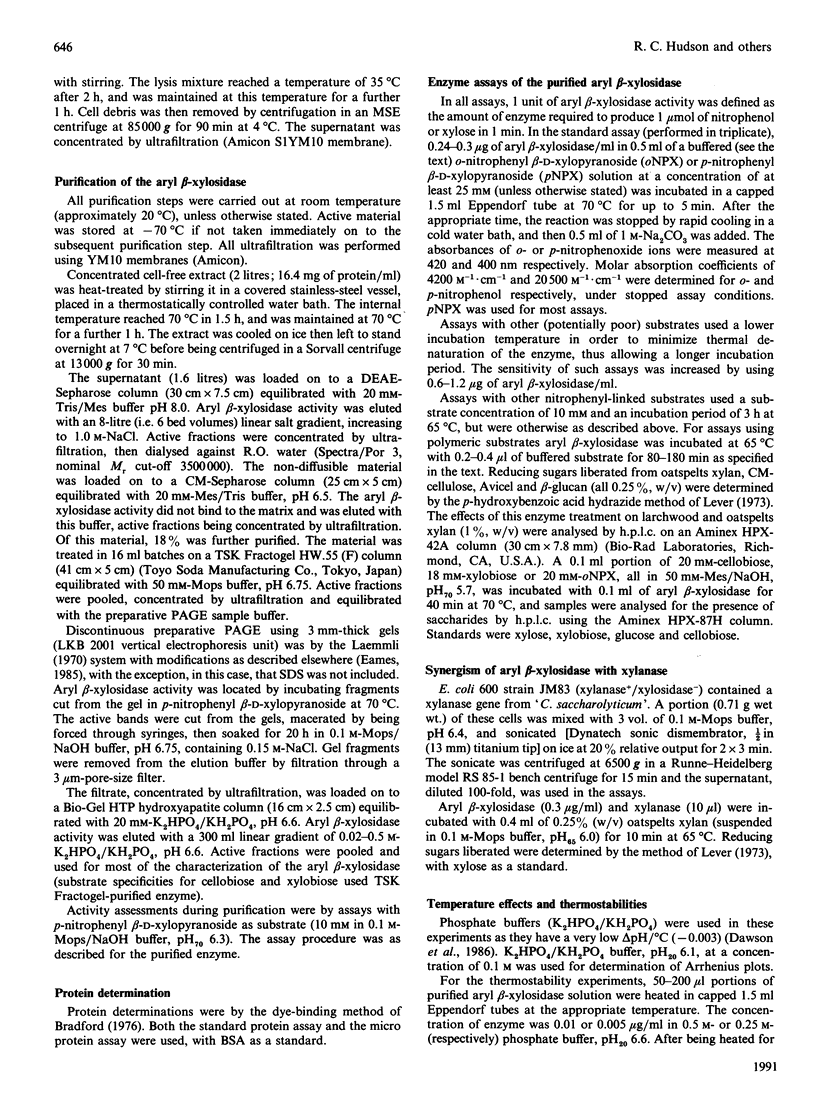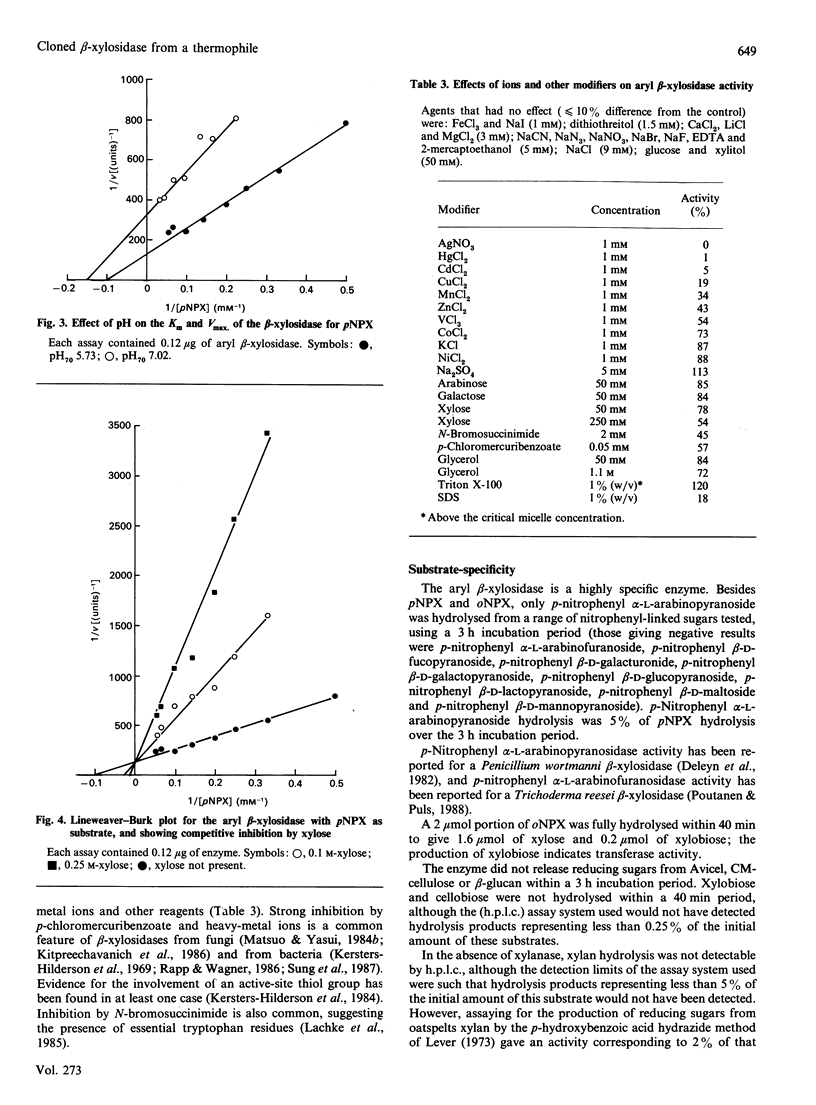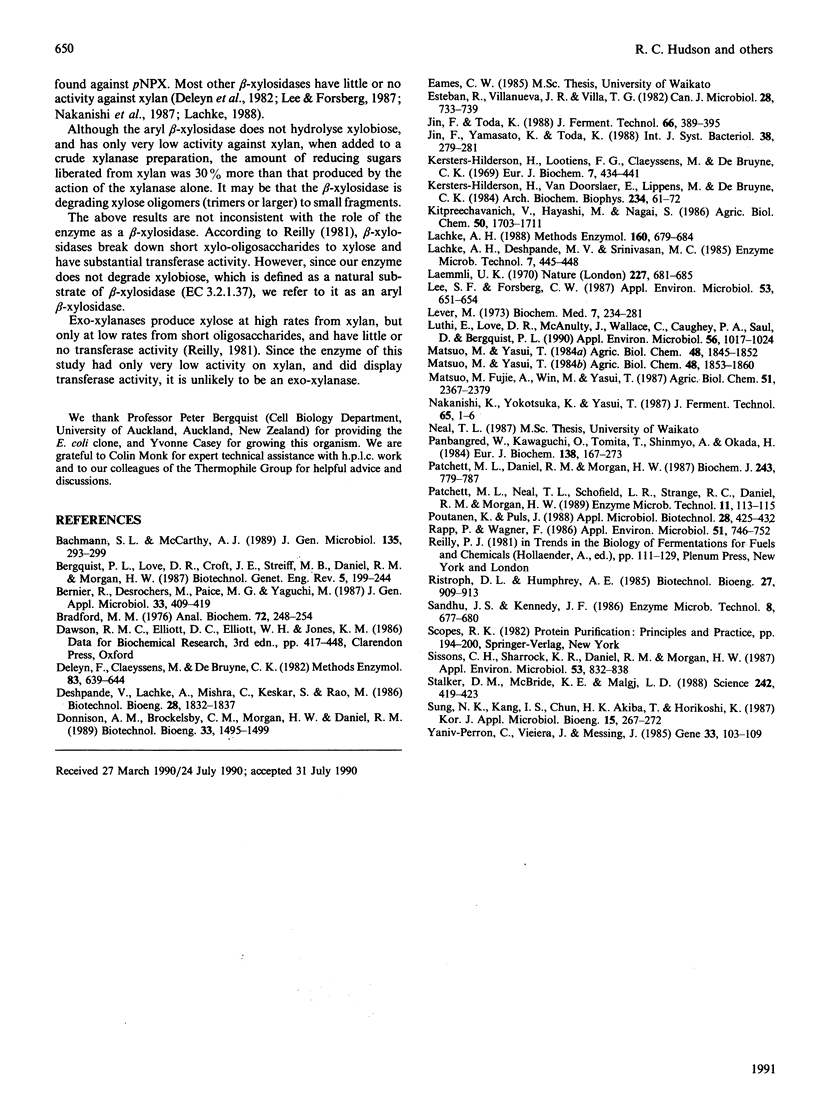Abstract
An aryl beta-xylosidase was purified to homogeneity from an Escherichia coli strain containing a recombinant plasmid carrying a beta-xylosidase (EC 3.2.1.37) gene from the extremely thermophilic anaerobic bacterium isolate Tp8T6.3.3.1 ('Caldocellum saccharolyticum'). It has a pI of 4.3 and shows optimal activity at pH 5.7. The enzyme is highly specific, acting on o- and p-nitrophenyl beta-D-xylopyranosides and minimally on p-nitrophenyl alpha-L-arabinopyranoside. It does not act on xylobiose. The Km for p-nitrophenyl beta-D-xylopyranoside at the optimum pH for activity is 10 mM, and at pH 7.0 is 6.7 mM. Xylose is a competitive inhibitor with Ki 40 mM. Thermal inactivation follows first-order kinetics at 65 and 70 degrees C with t1/2 values of 4.85 h and 40 min respectively. The t1/2 at 70 degrees C is increased 3-fold and 4-fold by the addition of 0.5 mg of BSA/ml and 2 mM-dithiothreitol respectively.
Full text
PDF





Selected References
These references are in PubMed. This may not be the complete list of references from this article.
- Bergquist P. L., Love D. R., Croft J. E., Streiff M. B., Daniel R. M., Morgan W. H. Genetics and potential biotechnological applications of thermophilic and extremely thermophilic micro-organisms. Biotechnol Genet Eng Rev. 1987;5:199–244. doi: 10.1080/02648725.1987.10647838. [DOI] [PubMed] [Google Scholar]
- Bradford M. M. A rapid and sensitive method for the quantitation of microgram quantities of protein utilizing the principle of protein-dye binding. Anal Biochem. 1976 May 7;72:248–254. doi: 10.1006/abio.1976.9999. [DOI] [PubMed] [Google Scholar]
- Deleyn F., Claeyssens M., De Bruyne C. K. beta-D-xylosidase from Penicillium wortmanni. Methods Enzymol. 1982;83:639–644. doi: 10.1016/0076-6879(82)83063-2. [DOI] [PubMed] [Google Scholar]
- Kersters-Hilderson H., Loontiens F. G., Claeyssens M., De Bruyne C. K. Partial purification and properties of an induced beta-D-xylosidase of Bacillus pumilus 12. Eur J Biochem. 1969 Jan;7(3):434–441. doi: 10.1111/j.1432-1033.1969.tb19628.x. [DOI] [PubMed] [Google Scholar]
- Kersters-Hilderson H., Van Doorslaer E., Lippens M., De Bruyne C. K. The pH dependence and group modification of beta-D-xylosidase from Bacillus pumilus: evidence for sulfhydryl and histidyl groups. Arch Biochem Biophys. 1984 Oct;234(1):61–72. doi: 10.1016/0003-9861(84)90324-2. [DOI] [PubMed] [Google Scholar]
- Laemmli U. K. Cleavage of structural proteins during the assembly of the head of bacteriophage T4. Nature. 1970 Aug 15;227(5259):680–685. doi: 10.1038/227680a0. [DOI] [PubMed] [Google Scholar]
- Lee S. F., Forsberg C. W. Isolation and Some Properties of a beta-d-Xylosidase from Clostridium acetobutylicum ATCC 824. Appl Environ Microbiol. 1987 Apr;53(4):651–654. doi: 10.1128/aem.53.4.651-654.1987. [DOI] [PMC free article] [PubMed] [Google Scholar]
- Lever M. Colorimetric and fluorometric carbohydrate determination with p-hydroxybenzoic acid hydrazide. Biochem Med. 1973 Apr;7(2):274–281. doi: 10.1016/0006-2944(73)90083-5. [DOI] [PubMed] [Google Scholar]
- Lüthi E., Love D. R., McAnulty J., Wallace C., Caughey P. A., Saul D., Bergquist P. L. Cloning, sequence analysis, and expression of genes encoding xylan-degrading enzymes from the thermophile "Caldocellum saccharolyticum". Appl Environ Microbiol. 1990 Apr;56(4):1017–1024. doi: 10.1128/aem.56.4.1017-1024.1990. [DOI] [PMC free article] [PubMed] [Google Scholar]
- Panbangred W., Kawaguchi O., Tomita T., Shinmyo A., Okada H. Isolation of two beta-xylosidase genes of Bacillus pumilus and comparison of their gene products. Eur J Biochem. 1984 Jan 16;138(2):267–273. doi: 10.1111/j.1432-1033.1984.tb07911.x. [DOI] [PubMed] [Google Scholar]
- Patchett M. L., Daniel R. M., Morgan H. W. Purification and properties of a stable beta-glucosidase from an extremely thermophilic anaerobic bacterium. Biochem J. 1987 May 1;243(3):779–787. doi: 10.1042/bj2430779. [DOI] [PMC free article] [PubMed] [Google Scholar]
- Rapp P., Wagner F. Production and Properties of Xylan-Degrading Enzymes from Cellulomonas uda. Appl Environ Microbiol. 1986 Apr;51(4):746–752. doi: 10.1128/aem.51.4.746-752.1986. [DOI] [PMC free article] [PubMed] [Google Scholar]
- Sissons C. H., Sharrock K. R., Daniel R. M., Morgan H. W. Isolation of cellulolytic anaerobic extreme thermophiles from new zealand thermal sites. Appl Environ Microbiol. 1987 Apr;53(4):832–838. doi: 10.1128/aem.53.4.832-838.1987. [DOI] [PMC free article] [PubMed] [Google Scholar]
- Stalker D. M., McBride K. E., Malyj L. D. Herbicide resistance in transgenic plants expressing a bacterial detoxification gene. Science. 1988 Oct 21;242(4877):419–423. doi: 10.1126/science.242.4877.419. [DOI] [PubMed] [Google Scholar]
- Yanisch-Perron C., Vieira J., Messing J. Improved M13 phage cloning vectors and host strains: nucleotide sequences of the M13mp18 and pUC19 vectors. Gene. 1985;33(1):103–119. doi: 10.1016/0378-1119(85)90120-9. [DOI] [PubMed] [Google Scholar]


